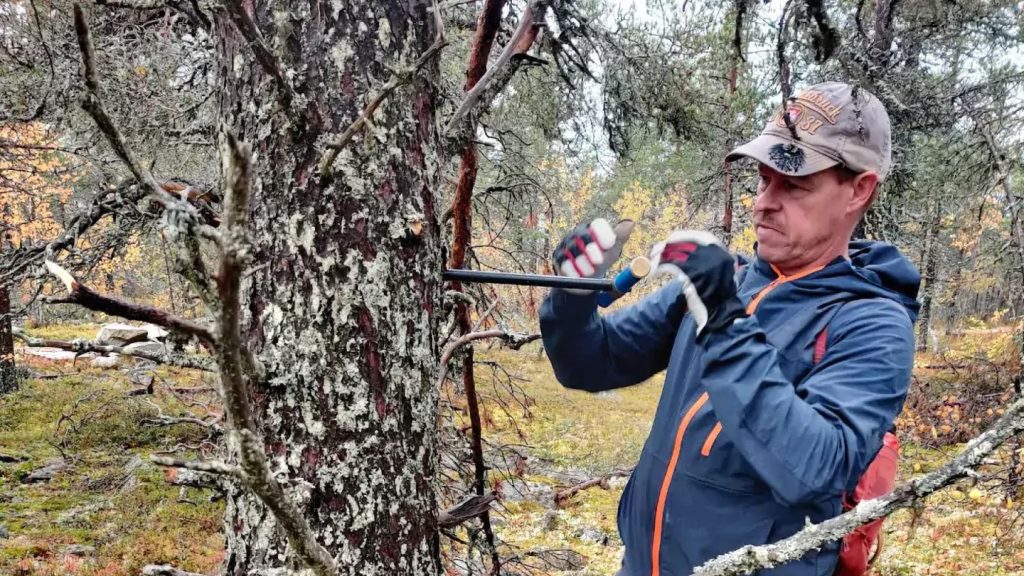The most powerful solar flare ever observed hit Earth's atmosphere in 1859, causing widespread aurorae and global disruption to telegraph systems. This historic event, known as the Carrington event, has long been difficult to find physical evidence of, but researchers now report that this mystery may have been solved in the March 16 issue of Geophysical Research Letters. lingering physical evidence of that storm, dubbed the Carrington event, has proven stubbornly elusive — until now, researchers report in the March 16 Geophysical Research Letters.
Ecologist Joonas Uusitalo and his colleagues at the University of Helsinki have discovered the first traces of the Carrington event in Finland’s far north by identifying carbon-14 atoms preserved in tree rings. Previous evidence of this event had not been found in tree rings, although other, more intense solar flares from 774 and 993 had left evidence in tree rings.
Uusitalo explains that the 1859 storm was less intense than the ones in 774 and 993, which is why it had not been detected before. He also notes that previous searches for evidence of the Carrington event had focused on trees in mid-latitudes, such as in Japan, Europe, or the United States, but the team thought that polar trees might be more sensitive to weaker storms based on their previous research.
The research team compared tree rings from three trees in Lapland, Finland, above the Arctic Circle, with three trees from mid-latitudes, all dating between 1853 to 1871. They discovered a significant increase in carbon-14 in the polar trees during the Carrington event year, suggesting that polar tree rings can be used to detect moderate-sized solar storms.
The researchers propose that the increased sensitivity of polar trees may be due to how solar particles interact with Earth’s magnetic field. Solar flares release particles that are deflected by Earth’s magnetic field toward the poles, creating aurorae and affecting radio signals.
When these particles reach the stratosphere, they react with atmospheric molecules to produce carbon-14, which is then drawn into living tree tissue, recording the solar flare. This phenomenon is known as Miyake events, named after physicist Fusa Miyake of Nagoya University in Japan, who linked the observed spikes in carbon-14 to solar storms.
The researchers note that previous assumptions about the distribution of carbon-14 in the atmosphere have been challenged by recent studies. It is now believed that in the Arctic, there is faster air exchange between the stratosphere and the troposphere, leading to a greater infusion of carbon-14 in trees closer to the poles, making them better detectors for weaker storms.
Uusitalo explains that recent studies have shown a faster air exchange between the stratosphere and the troposphere in the Arctic, leading to a slightly greater infusion of carbon-14 in trees closer to the poles, making them more effective sensors for weaker storms.
Uusitalo says that utilizing polar trees could offer researchers a better understanding of how frequent less severe solar storms are. There are indications from historical records that there were also eruptions in 1582, 1730, and 1770 which haven't been detected in tree rings at mid-latitudes. His team plans to search for these eruptions nearer to the north pole.
Physicist Benjamin Pope from the University of Queensland in St. Lucia, Australia, believes that the discovery could be very important for scientists' comprehension of spikes in radiocarbon levels in tree rings. He points out that it has been a longstanding issue that the largest solar flare ever observed – the Carrington event of 1859 – does not appear in the radiocarbon record.
Pope and his colleagues recently questioned whether solar flares were even responsible for the Miyake events, based in part on uncertainties in how well the spikes align with the solar cycle, as well as on the apparent lack of evidence that trees nearer the poles contain higher levels of the carbon-14 (SN: 11/7/22). If the new findings hold true, they provide additional evidence supporting the connection between the Miyake events and solar storms. However, Pope states that this study's results are based solely on three trees in polar regions, and it will be crucial to replicate these results with other high-latitude trees before making any conclusions.
Uusitalo concurs and emphasizes the importance of examining tree rings that cover longer time spans, beyond a single 11-year solar cycle. This is because solar activity may impact carbon-14 production in the atmosphere in another manner: the solar wind can actually deflect cosmic rays away from Earth, periodically reducing the normal influx of rays that contribute to carbon-14 formation in the atmosphere. If this subtle cycle is also detectable in polar tree rings, the trees could provide a new method for studying the historical cyclicity of the sun and atmospheric circulation.
In any case, Uusitalo stresses the significance of studying high-latitude trees. Most measurements come from mid-latitudes as scientists tend to analyze trees closer to their own locations. Nonetheless, as indicated by this study, trees in the far north may hold many secrets about the interconnected history of Earth and the sun.



